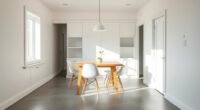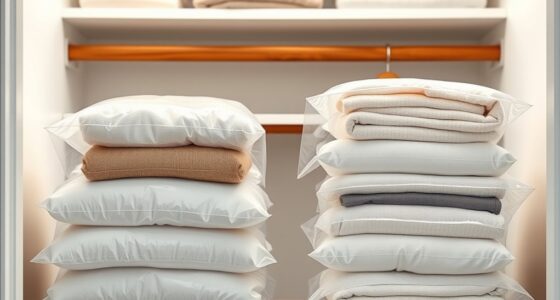I’ve found that the best 3D printers for creating concrete model houses combine high precision, durable materials, and real-world realism. These machines feature advanced nozzle systems, large build volumes, and weather-resistant properties, making them perfect for architectural models. They support innovative techniques like multi-color printing and remote monitoring, which help bring design ideas to life effortlessly. If you want to discover the top options and what makes them stand out, keep exploring more details ahead.
Key Takeaways
- Highlight advanced 3D printers capable of creating detailed, durable concrete models with high precision and realistic architectural features.
- Emphasize features like large build volumes, precise layer resolution, and weather-resistant materials for realistic, structural models.
- Showcase innovative printing technologies, such as multi-color and multi-material capabilities, enhancing design authenticity.
- Focus on user-friendly, safe enclosed printers suitable for educational and professional use in architectural modeling.
- Include examples of model houses demonstrating complex geometries, realistic textures, and structural integrity achieved through 3D concrete printing.
ELEGOO PLA Filament 1.75mm Marble Cement Gray 1KG
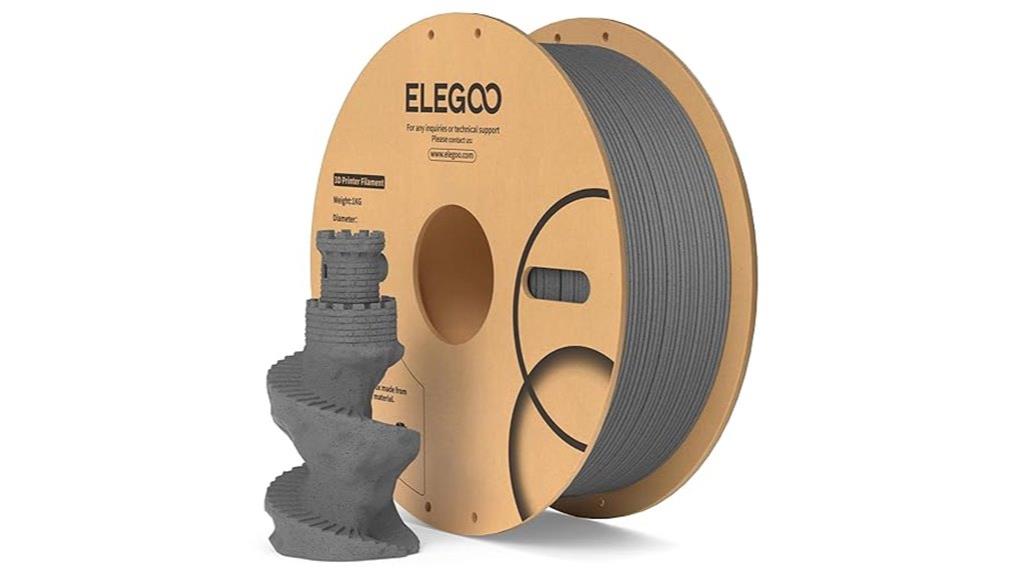
If you’re aiming to create realistic, stone-like finishes on your 3D printed concrete model houses, ELEGOO PLA Filament 1.75mm Marble Cement Gray 1KG is an excellent choice. Its fine marble powder gives models a natural, matte marble appearance with sharp detail and strong adhesion. The filament’s consistent diameter (+/- 0.02mm) ensures smooth printing and minimal stringing or warping. Vacuum-sealed packaging keeps it dry, preventing clogs, while full mechanical winding reduces tangles. Compatible with most 1.75mm FDM printers, it delivers reliable, high-quality results straight out of the box, making it ideal for detailed, stone-like architectural models.
Best For: hobbyists, artists, and professionals seeking realistic, stone-like finishes on detailed architectural models and sculptures with consistent quality and minimal post-processing.
Pros:
- Produces a natural matte marble finish with sharp detail and strong adhesion.
- Consistent filament diameter (+/- 0.02mm) ensures smooth, stable printing with minimal stringing and warping.
- Vacuum-sealed packaging and full mechanical winding help maintain filament dryness and reduce tangles.
Cons:
- Some users report occasional adhesion issues or clogging, especially with certain batches or PLA+ variants.
- Proper storage, drying, and maintenance are critical; moisture or hardware issues can affect print quality.
- Compatibility and performance may vary depending on printer hardware and settings, requiring profile adjustments.
Tina2S 3D Printer with WiFi Cloud Printing

The Tina2S 3D Printer with WiFi Cloud Printing stands out as an ideal choice for beginners, kids, and educational settings thanks to its compact and user-friendly design. It arrives fully assembled, with preloaded models on a TF card and an app, making setup effortless. Its built-in LED light helps monitor prints in real-time, perfect for learners. The upgraded WiFi module delivers five times faster file transfer, and the Poloprint Cloud app simplifies network setup. With auto leveling, a removable build plate, and high precision (0.04mm), it ensures successful, detailed prints. Quiet operation and multiple control options make it versatile for home, school, or office use.
Best For: beginners, children, and educators seeking an easy-to-use, reliable 3D printer for learning and creative projects.
Pros:
- Fully assembled, ready to use out-of-the-box, ideal for beginners and kids
- Supports multiple control options including app, USB, and Wiibuilder software
- Auto leveling and removable build plate simplify operation and maintenance
Cons:
- Limited build volume due to its compact size
- May lack advanced features for professional or highly detailed industrial printing
- Slightly higher cost compared to basic entry-level 3D printers
Geeetech Mini 3D Printer for Kids and Beginners
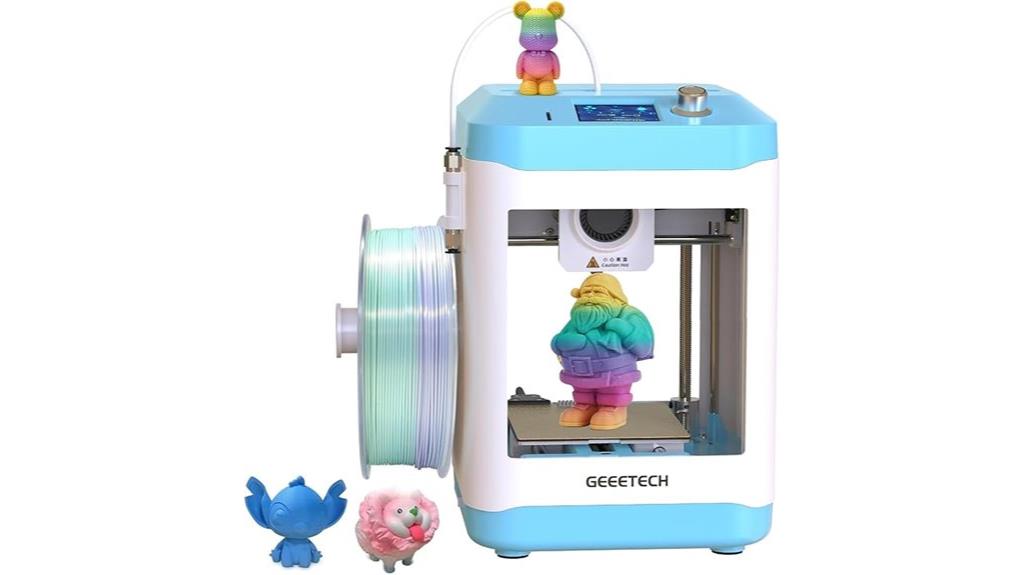
Designed specifically for kids and beginners, the Geeetech Mini 3D Printer offers a simple, fully assembled setup that makes 3D printing accessible without any prior experience. Its plug-and-play operation via TF card allows for easy use, while automatic 16-point leveling guarantees precise, smooth prints. The flexible magnetic build plate simplifies removal and cleaning, reducing warpage. With a dual-drive metal gear extruder, it supports various filaments like TPU and PLA, delivering reliable, high-speed performance up to 250mm/sec. Compact and user-friendly, it’s perfect for home, school, or DIY projects, making 3D printing fun and approachable for newcomers.
Best For: beginners, kids, and educators seeking an easy-to-use, fully assembled 3D printer for educational, creative, or hobby projects.
Pros:
- Fully assembled and ready to use, ideal for beginners and kids.
- Automatic 16-point leveling ensures precise, smooth prints with minimal effort.
- Supports a variety of filaments like TPU and PLA, with high-speed printing up to 250mm/sec.
Cons:
- Limited build volume may restrict larger project sizes.
- Slightly higher price point compared to basic entry-level 3D printers.
- May require occasional maintenance or troubleshooting for optimal performance.
Tina2 Mini 3D Printers for Home Use

For beginners and hobbyists looking for an easy-to-use 3D printer, the Tina2 Mini by WEEDO stands out thanks to its fully assembled, plug-and-play design. It’s compact, lightweight (just 6.6 lbs), and easy to set up—usually within 15 minutes without tools. Its semi-enclosed design enhances safety, especially for kids or classroom use. The printer’s small print area supports miniatures and prototypes, while features like auto-leveling and a flexible print bed make model removal simple. With open-source firmware, you can customize and upgrade it easily. Overall, Tina2 Mini offers a reliable, user-friendly entry point into 3D printing for home and educational environments.
Best For: beginners, hobbyists, and educators seeking an easy-to-use, compact 3D printer for small models and educational projects.
Pros:
- Fully assembled and plug-and-play, allowing quick setup without tools
- Compact and lightweight design, ideal for home, classroom, or hobby use
- Auto-leveling and flexible print bed simplify operation and model removal
Cons:
- Small print area may limit larger project options
- Wi-Fi printing may require workaround for setup
- Initial setup requires bed leveling and safety checks, supervision recommended for kids
Official Creality Ender 3 3D Printer
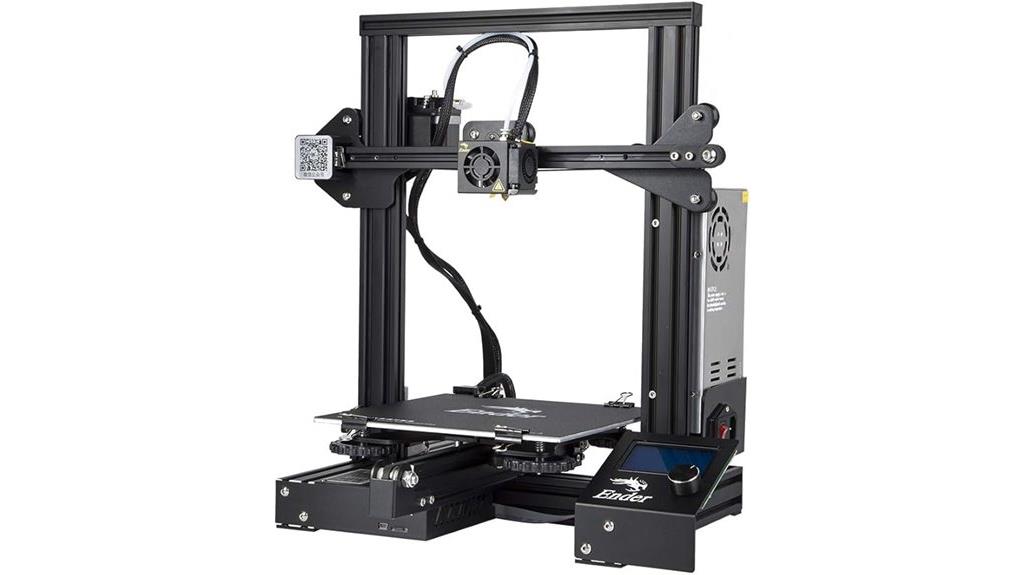
If you’re a student or beginner looking to plunge into 3D printing, the Creality Ender 3 offers an excellent starting point. Its open-source design and DIY assembly make it accessible and customizable, with a build volume of 8.66”x8.66”x9.84”. It’s easy to set up, taking about two hours, and features a resume function to continue prints after power interruptions. The advanced extruder reduces clogs, while V-shape POM wheels ensure smooth, quiet movement. Safety is prioritized with a protected power supply, and quality control guarantees reliable performance, making this a solid choice for educational, hobbyist, and beginner projects.
Best For: students, beginners, and hobbyists seeking an affordable, easy-to-assemble 3D printer for educational and DIY projects.
Pros:
- Open-source design allows for customization and upgrades.
- Easy assembly process, approximately two hours, ideal for beginners.
- Features a resume function to continue printing after power outages, enhancing reliability.
Cons:
- Does not support phone connectivity, limiting remote control options.
- Build volume, while sufficient for beginners, may be restrictive for larger projects.
- Requires verification of power supply voltage to prevent auto shut-offs and ensure safety.
Geeetech 3D Printer for Kids & Beginners
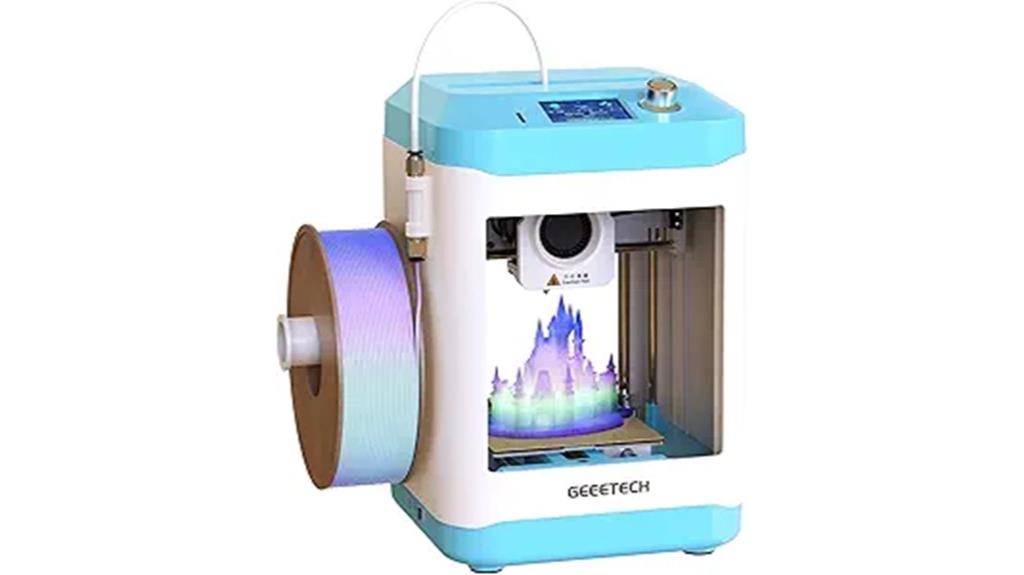
The Geeetech 3D Printer for Kids & Beginners stands out as an excellent choice for newcomers to 3D printing, thanks to its user-friendly features and straightforward operation. It arrives fully assembled, with simple knob controls and one-button filament loading, making setup hassle-free. The 2.4-inch color LCD screen and high-brightness lighting improve usability, perfect for educational settings or home projects. With a powerful 50W heating rod and advanced nozzle, it delivers stable, high-speed prints up to 250mm/s. Its auto-leveling build plate and flexible magnetic surface guarantee precise, easy model removal. Plus, lifetime support and a 12-month repair guarantee make it a reliable, beginner-friendly option.
Best For: beginners, kids, and educators seeking an easy-to-use, fully assembled 3D printer for educational or home projects.
Pros:
- Fully assembled design with simple knob controls and one-button filament loading for hassle-free setup
- Supports high-speed printing up to 250mm/s with stable performance using advanced nozzle and 50W heating rod
- Auto-leveling technology and flexible magnetic build plate ensure precise print adhesion and easy removal
Cons:
- Limited build volume size may restrict larger project options
- Requires a filament holder for 1kg filament stability, which must be printed separately
- May need initial calibration or troubleshooting for optimal performance in some setups
3D Printer with 8 PLA Filament Set and Wi-Fi Control
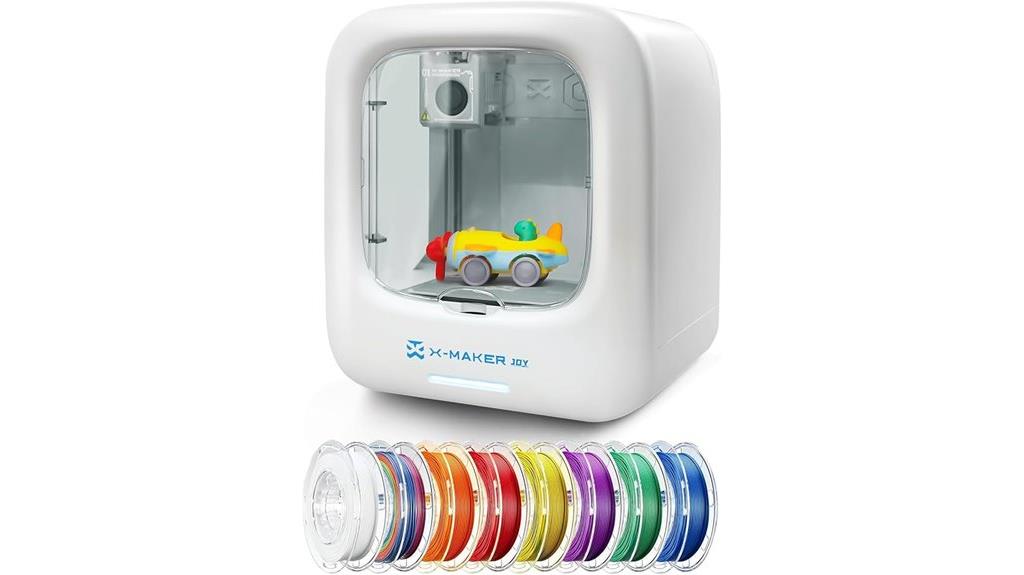
The D Printer with 8 PLA Filament Set and Wi-Fi Control stands out as an excellent choice for beginners and educators, thanks to its user-friendly design and versatile features. It offers one-click operation via a smart app compatible with iOS, Android, and Windows, making setup straightforward. The printer boasts automatic bed leveling, a large build volume, and a quick-change nozzle system that delivers detailed prints at speeds up to 200mm/s. Its enclosed design encourages customization through a DIY interface, fostering creativity. While some users face connectivity issues, its educational value and ease of use make it a compelling option for those new to 3D printing.
Best For: beginners, educators, and families seeking an easy-to-use 3D printer with educational value and customizable features.
Pros:
- User-friendly with one-click operation and app control across multiple platforms
- Automatic bed leveling and quick-change nozzle for high-quality, detailed prints
- Enclosed design that encourages creativity and personalization through DIY interfaces
Cons:
- Connectivity issues such as Wi-Fi disconnection and camera offline problems reported by some users
- Firmware update challenges and inconsistent print quality after initial use
- Hardware problems like the Hotend dislodging during transit, leading to potential maintenance needs
Anycubic Kobra 3 V2 3D Printer
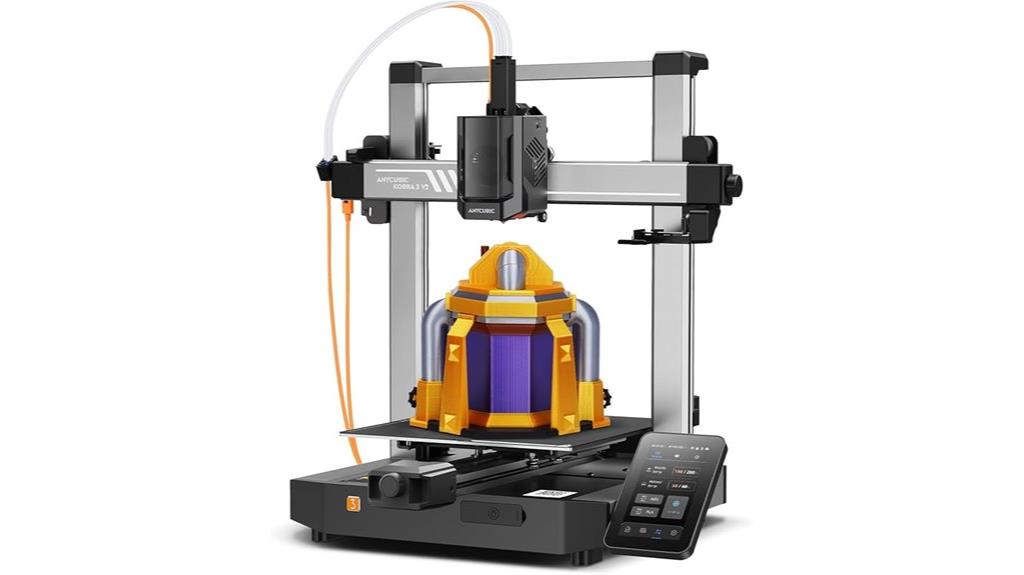
Looking for a 3D printer that combines speed and multi-color capabilities? The Anycubic Kobra 3 V2 might be just what you need. It supports multi-color printing with optional ACE Pro modules—one for 4-color and two plus an 8-Color Filament Hub for even more options. This printer boasts incredible speeds up to 600mm/s, reducing print times noticeably, like creating a Benchy in around 11.5 minutes. It features a built-in 720p HD camera for remote monitoring and time-lapse videos. With a one-year warranty, lifetime support, and access to thousands of models via MakerOnline, it’s a versatile choice for innovative, high-quality printing.
Best For: Makers and professionals seeking high-speed, multi-color 3D printing with remote monitoring capabilities.
Pros:
- Supports multi-color printing with optional ACE Pro modules for versatile color options.
- Boasts blazing-fast print speeds up to 600mm/s, significantly reducing project time.
- Equipped with a built-in 720p HD camera for remote monitoring and time-lapse creation.
Cons:
- Additional ACE Pro modules are required for multi-color printing, increasing overall cost.
- The printer’s size and weight (255×255×260mm, 20.2 pounds) may require dedicated space and setup.
- Limited warranty coverage for the print head (three months) compared to other components.
3D Printer for Kids with PLA Filament Set and App Control
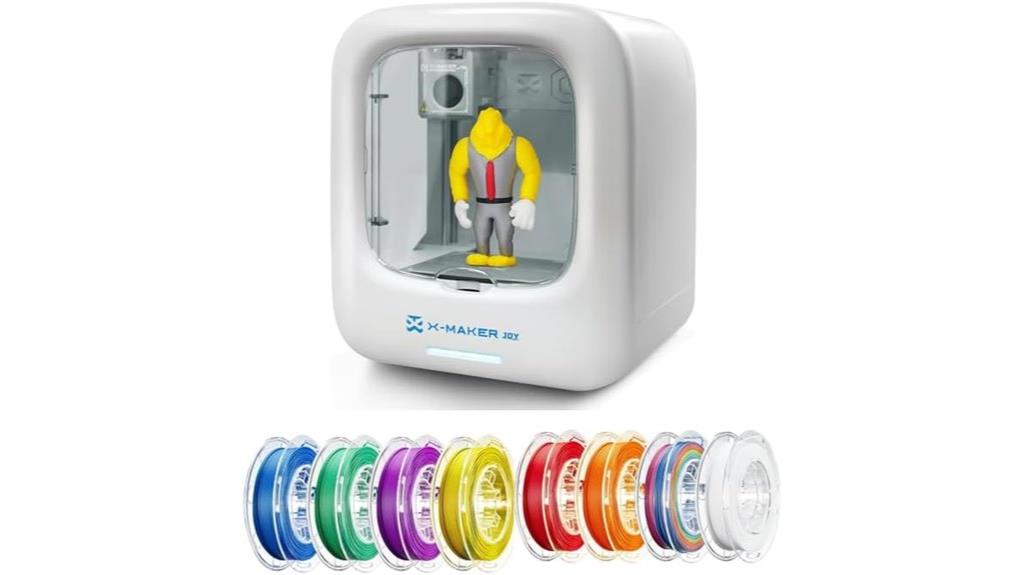
If you’re searching for a beginner-friendly 3D printer that sparks your child’s creativity, the X-Maker Joy stands out with its app control and Wi-Fi connectivity. It’s compatible with iOS, Android, and Windows, making setup quick and simple—just one click through the smart app. The printer comes with eight PLA filament spools, offering endless color options and fun. With a high precision of 0.05mm and speeds up to 200mm/s, it produces detailed, smooth prints. The built-in camera allows real-time monitoring, while voice commands and a large digital library keep kids engaged and inspired. It’s perfect for young creators and STEM learning at home.
Best For: parents and educators seeking an easy-to-use, engaging 3D printing solution to inspire children’s creativity and STEM skills at home or in the classroom.
Pros:
- User-friendly setup with app control and Wi-Fi connectivity for effortless operation.
- Comes with eight colorful PLA filament spools and access to over 1,500 digital designs, fostering endless creative projects.
- Built-in camera and voice command features enable real-time monitoring and interactive use, making it suitable for kids and beginners.
Cons:
- First available date listed as April 7, 2025, which suggests it may be a future product or pre-order item.
- Customer rating is 4.0 stars, indicating some users may experience issues or limitations.
- Requires compatible devices and internet connection, which may be a barrier for some users in areas with limited connectivity.
Beginner 3D Printer with Filament Set and App Control
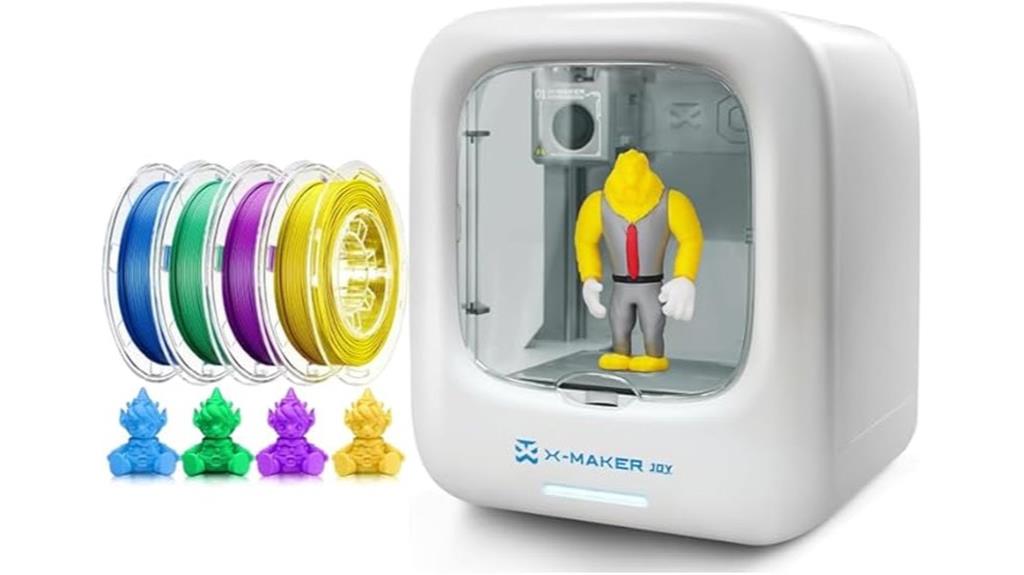
A beginner-friendly 3D printer like the AOSEED model stands out with its easy app control, making it perfect for newcomers, kids, and home users. It comes with a 4-color PLA filament set and offers Wi-Fi connectivity, allowing you to control prints via iOS, Android, or Windows devices. The printer delivers precise results with 0.05mm accuracy at speeds up to 200mm/s. Its quick-release nozzle simplifies maintenance, and the high-quality filament guarantees smooth, vibrant finishes. With access to over 1,500 digital designs and themed modules, it’s ideal for creative projects, STEM learning, and family fun, all in a user-friendly package.
Best For: beginners, kids, and home users seeking an easy-to-use 3D printer with app control, educational features, and vibrant design options.
Pros:
- User-friendly app control compatible with iOS, Android, and Windows for convenient remote operation
- Comes with a versatile 4-color PLA filament set and access to over 1,500 digital designs for creative projects
- Achieves high-precision printing at 0.05mm with speeds up to 200mm/s, ensuring detailed and smooth results
Cons:
- Listing availability begins from April 7, 2025, so it is not yet available for purchase
- Limited information on advanced features or upgrade options for experienced users
- Requires internet/Wi-Fi connection for app control, which may be a limitation in low-connectivity environments
3D Printer for Kids with PLA Filament Set and App Control
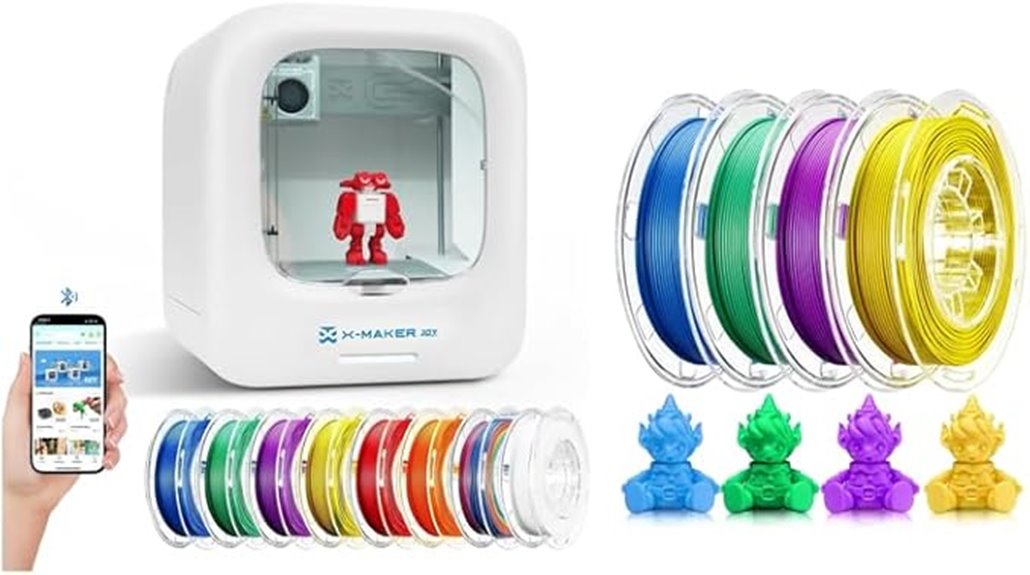
This 3D printer is perfect for kids and beginners because it combines user-friendly features with advanced safety and control options. It’s easy to set up with a one-click start via a smart app, supporting voice commands for added accessibility. The fully enclosed design guarantees safe operation, while the no-leveling platform simplifies use. With high precision at 0.05 mm accuracy and speeds up to 200 mm/s, it produces quality prints effortlessly. The kit includes everything needed—PLA filaments, tools, and a design library—making it ideal for educational projects and creative exploration. It’s a fun, safe way for kids to learn and create with 3D printing.
Best For: parents, educators, and kids interested in safe, easy-to-use 3D printing for creative learning and STEM projects.
Pros:
- User-friendly setup with app control and voice command support.
- Fully enclosed design ensures safety for children.
- High precision and fast printing speeds deliver quality results easily.
Cons:
- Only available starting April 29, 2025, so not currently accessible.
- Limited to PLA filament, which may restrict material variety.
- The initial cost may be higher compared to basic 3D printers without educational features.
Factors to Consider When Choosing a 3D Printer Concrete Model House
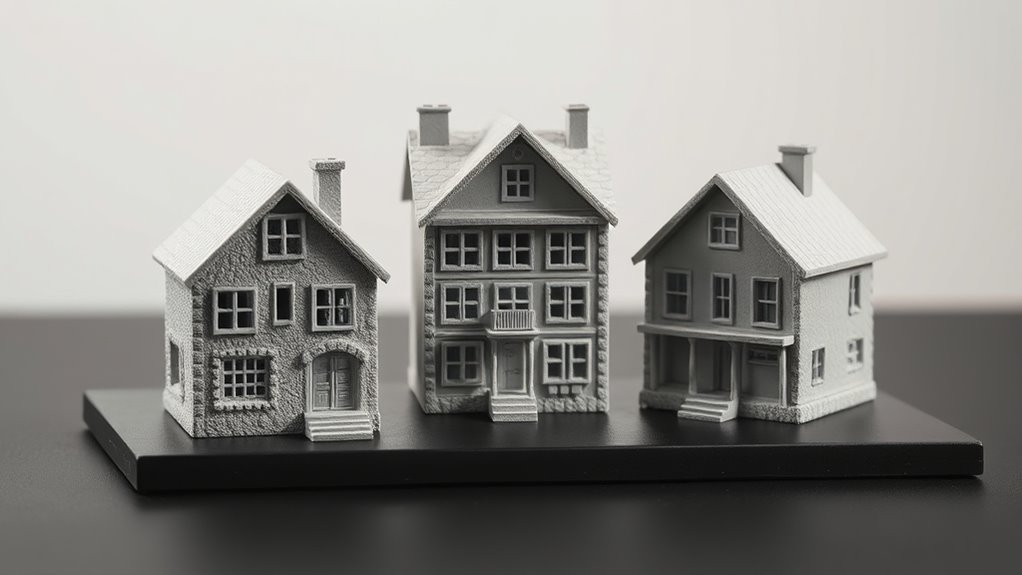
When selecting a 3D printer for concrete models, I focus on key factors like material compatibility and strength to guarantee durability. Precision and build size matter for capturing details and creating larger projects, while ease of use features can save time and reduce frustration. Additionally, considering weather resistance and overall durability helps ensure your models last over time.
Material Compatibility and Strength
Choosing the right 3D printer for concrete model houses hinges on guaranteeing the machine supports durable, cement-based materials that can withstand environmental stresses. It is crucial to verify that the filament or mixture used has sufficient compressive and tensile strength to maintain structural integrity and durability. Compatibility with high-viscosity or heavy-duty concrete mixtures is critical to avoid clogging and ensure smooth extrusion during printing. Additionally, I look for printers with nozzles and heating systems designed to handle the abrasive and thermal properties of concrete materials, reducing wear and tear. The bonding strength of the material, along with its ability to adhere properly to previous layers, also plays an important role in building accurate, stable, and long-lasting concrete model houses.
Printing Precision and Detail
Accurate printing precision is essential for capturing the intricate details and complex features of concrete model houses. A high resolution, measured in microns, ensures small architectural elements are sharply defined. Using a nozzle diameter between 0.2mm and 0.4mm allows for finer layer resolution, vital for detailed textures and ornamentation. Consistent layer height, typically between 0.1mm and 0.2mm, results in smooth surfaces and crisp edges. A stable, precise extruder minimizes layer misalignments and stringing, boosting overall realism. Keep in mind, higher resolution often means slower print speeds to maintain accuracy. This trade-off is crucial when aiming for models that truly reflect the complexity and finesse of real houses. Prioritizing precision guarantees your concrete models will stand out with exceptional detail.
Build Size and Capacity
The build size of a 3D printer directly limits the maximum dimensions of your concrete model house, shaping the overall design possibilities and functionality. A larger build volume allows for more ambitious, expansive structures, but it also means more material and longer printing times, which can increase costs and extend project timelines. It’s essential to match the printer’s capacity with your intended house size to avoid complex assembly or the need for multiple prints. The dimensions of the print bed determine how large individual sections can be printed in one piece, impacting the final structure’s seamlessness. When choosing a printer, consider both your current project scope and potential future expansions, ensuring the build size aligns with your long-term goals.
Ease of Use Features
When selecting a 3D printer for concrete model houses, ease of use can make or break your experience. A user-friendly printer should have automatic bed leveling to guarantee precise adhesion without manual adjustments, saving time and effort. Intuitive interfaces, like LCD screens or app controls, make operation straightforward, especially for beginners. Simplified filament loading and maintenance processes reduce setup time and lower the chance of errors during printing. Features like quick-change nozzles and guided tutorials help users handle complex tasks with minimal technical knowledge. Clear safety features, such as enclosed designs and automatic shutdowns, enhance usability and protect users from potential hazards. Overall, these features streamline the printing process, allowing you to focus on creativity rather than technical frustrations.
Durability and Weather Resistance
Choosing a 3D printer capable of producing weather-resistant concrete models requires attention to materials and construction techniques. I look for models made with fiber-reinforced or sealed concrete, as these materials withstand moisture, UV rays, and wind better. Proper curing and sealing are vital; they prevent cracking, erosion, and water infiltration over time. Adding waterproofing agents or polymer modifiers during printing can further enhance durability. The thickness of the walls and the reinforcement quality also play a significant role in resisting weather-related wear and tear. Regular maintenance, like cleaning and resealing, is essential to keep the model’s structural integrity intact, especially in harsh climates. Prioritizing these factors ensures the model remains resilient and true to its purpose outdoors.
Cost and Maintenance
Investing in a 3D printer for concrete model houses involves significant upfront costs, which can range widely based on size, precision, and features. These printers can cost from several thousand to tens of thousands of dollars. Beyond the initial purchase, maintenance expenses add up over time, including replacing nozzles, print beds, and extruders. Regular calibration and cleaning are essential to maintain consistent quality and prevent issues like clogging or mechanical failures. The durability of the printer’s components influences long-term repair costs; higher-quality parts typically reduce these expenses. Additionally, operational costs such as specialized concrete or mortar materials and energy consumption should be considered. Balancing initial investment with ongoing maintenance and material costs is vital for making a cost-effective choice.
Frequently Asked Questions
How Durable Are 3d-Printed Concrete Model Houses Long-Term?
3D-printed concrete model houses are quite durable long-term, especially when made with high-quality materials and proper curing techniques. I’ve seen their strength comparable to traditional construction, capable of withstanding weather and daily wear. Of course, like any structure, maintenance is key to longevity. I believe with ongoing advancements, these homes will become even more resilient, offering a sustainable and innovative solution for future housing needs.
Can 3D Printers Handle Full-Scale Concrete House Construction?
They say “Rome wasn’t built in a day,” and while 3D printers are advancing fast, handling full-scale concrete house construction is still a challenge. Currently, most printers are used for smaller structures or components. However, with ongoing innovation, I believe larger, full-scale projects will soon become feasible. For now, I see 3D printing as a powerful tool to revolutionize construction—just not quite replacing traditional methods yet.
What Are the Environmental Impacts of 3D Printed Concrete Houses?
The environmental impacts of 3D printed concrete houses are mixed. I see benefits like reduced waste and faster construction, which lower overall resource use. But I also worry about the carbon footprint from cement production and energy consumption during printing. It’s essential we develop greener materials and energy-efficient methods to make this technology truly sustainable and eco-friendly in the long run.
How Much Does It Cost to Print a Concrete Model House?
Imagine I’ve got a time machine, and I’m bringing back the cost of printing a concrete model house. It typically ranges from $10,000 to $50,000, depending on size, complexity, and location. I’ve seen some projects come in cheaper with efficient designs, while larger, more detailed houses push the price higher. Keep in mind, ongoing expenses like materials and labor also play a role in overall costs.
Are There Design Limitations With 3D Printed Concrete Home Models?
Yes, there are design limitations with 3D printed concrete home models. I’ve found that complex curves and intricate details can be challenging to attain consistently due to printer resolution and material properties. Additionally, large structures may require careful planning to guarantee stability during printing. However, advances in technology are gradually overcoming these hurdles, allowing for more creative and realistic designs over time.
Conclusion
So, whether you’re into sleek designs or aiming for realistic details, choosing the right 3D printer can truly transform your concrete model houses. I’ve found that blending innovation with quality often leads to the best results—kind of like how these top picks unexpectedly align with what I was looking for. Ultimately, it’s about finding that perfect balance between features and affordability, making your creative process smoother and more inspiring.

